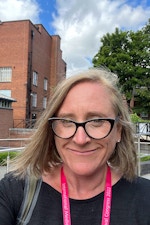Dr. Kathryn Jasper

- About
- Education
- Awards & Honors
- Research
Biography
Kathryn Jasper earned her doctorate in history and a concurrent PhD in medieval studies from the University of California, Berkeley. She has taught ancient and medieval history, Latin, and Latin paleography at ISU since 2012. Dr. Jasper chairs the Latin section in the Department of Languages, Literatures, and Cultures. If you are interested in the Classical Studies Minor, please visit:
https://lan.illinoisstate.edu/latin/
Dr. Jasper is also co-director of a summer archaeological field school in Gradoli (Bolsena), Italy.
https://about.illinoisstate.edu/vallegianni/
If you would like to know more about Paleography Illuminated, an online hub for transcriptions of ISU's manuscript collection, please visit our site:
https://about.illinoisstate.edu/manuscriptproject/
If you would like to know more about Traveler's Lab at ISU, a collaboration among universities bringing together students and professional scholars to study pre-modern history using digital methods, please visit:
http://travelerslab.research.wesleyan.edu
Current Courses
HIS 287.005 Independent Study
HIS 398.002 Professional Practice: Internship in Historical Research
LAT 300.001 Research in Latin
HIS 308.002 Selected Topics In European History
HIS 408.002 Selected Topics In European History
HIS 223.001 The Middle Ages: 1100-1500
HIS 101.001 Western Civilization To 1500
HIS 101.002 Western Civilization To 1500
HIS 287.003 Independent Study
ANT 287.003 Independent Study In Anthropology
HIS 398.002 Professional Practice: Internship in Historical Research
HIS 490.002 Readings -- Field Of Study
LAT 115.001 Second-Year Latin (Part I)
HIS 300.006 Senior Seminar In History
HIS 222.001 The Middle Ages: 395-1100
Teaching Interests & Areas
My courses examine the major social and political transformations of the Roman and medieval Mediterranean Basin, from Western and Central Europe, to North Africa, Byzantium, and the Middle East. I ask that my students engage multiple sources beyond documents, such as monuments, art, and architecture. Some of my courses include an undergraduate seminar on the city of Rome, a graduate seminar on the historiography of the central Middle Ages, the Italian Renaissance (usually taught as part of the ISU Orvieto study abroad program), and a two-part class on the Middle Ages from 200-1100, and 1100-1500, respectively. I teach Latin 115, the Introduction to Paleography course, and Advanced Latin Paleography in the Department of Languages, Literatures, and Cultures.
Research Interests & Areas
My current research project is an archaeological excavation of a Roman imperial period, monumental fountain located 300 meters from the western coast of Lake Bolsena in central Italy. Its high quality of construction and materials and its remote rural location suggests the fountain was part of a larger complex, likely a Roman villa. Answering questions about the identity and motivations of the fountain’s patron hinges on uncovering how its construction related to the agrarian economy, to routes of export and import, and consumption of goods in the region. My approach blends analysis of historical documents with modern datasets of the physical environment, when relevant, to generate hypothetical ancient and medieval landscapes and practices in GIS databases for analysis.
My first book, entitled Bounded Wilderness: Land and Reform at the Hermitage of Fonte Avellana, ca. 1035-1072 (Cornell University Press, 2024), studies economic practices, religious traditions, and the natural environment in tandem to shed light on another side of religious reform.
Ph D History
MA History
BA Anthropology
Outstanding College Researcher
Outstanding CAS Teacher Award
Teaching Innovations Grant
Impact Award
Internationalization Award
University Teaching Initiative Award
CAS Excellence Award for Outstanding Teaching by a Pre-tenured Faculty Member
Teaching Initiative Award Nominee
Research Initiative Award Nominee
Grants & Contracts
Book, Authored
Book, Chapter
Journal Article
Presentations
“Women in the Wilderness: Hermitism and Female Mobility.” 31st International Medieval Congress, University of Leeds, Leeds, UK, July 1, 2024.